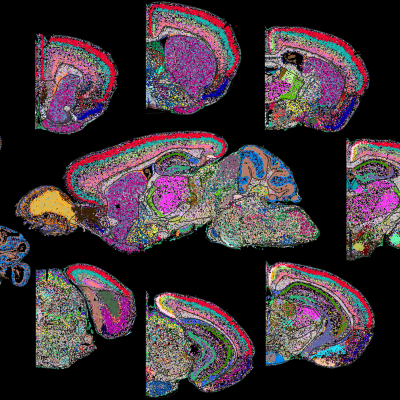IMAXT
Led by Professor Greg Hannon (CRUK Cambridge Institute, UK).The challenge
In 2017, the IMAXT team set out to tackle the 3D tumour mapping challenge.
At the time, the ‘single-cell revolution’ had only just begun. It was known that cancer cells exist within an increasingly complex, interactive ecosystem, and there was a growing appreciation for the role of tumour heterogeneity and the microenvironment in cancer progression, metastasis and therapeutic resistance. Yet, spatial-multi-omics was barely imagined, and single-cell technologies were emerging, difficult to interpret, and often untested in more challenging tissue-types, let alone intact tissues, such as primary tumours and metastases.
Team IMAXT proposed to develop a platform, bringing together advanced imaging approaches with cutting-edge technologies, most of which were still in their infancy, for measuring DNA, RNA and protein on a single-cell level. Importantly, the team would also preserve spatial information- location and context would be key. IMAXT then planned to integrate this complex data and visualise them in an interactive 3D map using virtual reality (VR). Creating such a precise, detailed 3D map would capture the complexity of intra-tumour architecture and provide an entirely new way to study cancer.
At a glance
Team and leadership
IMAXT was led by:
IMAXT assembled a multi-national team of scientists, spanning five countries. To achieve their ambitious goal, they had experts from fields rarely brought together- from medicine and astronomy, to VR and statistics, programming and molecular biology. Critically the team included those who had pioneered the techniques that would be further developed as part of IMAXT. This diverse expertise would be crucial, enabling the team not just to improve upon innovative techniques, but also invent entirely new ones, going on to allow their implementation in a robust manner and integrating them on an unprecedented scale.
Tackling the 3D tumour mapping challenge
To study the tumour microenvironment as a whole, cell-by-cell, and to analyse genome structure, gene and protein expression simultaneously, whilst retaining positional information, advances in imaging, single-cell and spatial technologies were critical. The team planned to combine techniques and data handling methods to provide user-friendly, spatially and molecularly annotated datasets enriched with multiple layers of information to answer important questions in cancer biology.
The team has been successful in its endeavours and has been at the forefront of the emerging spatial biology revolution. The cutting-edge IMAXT platform integrates multiple different technologies, from bulk profiling and 3D whole organ imaging, to spatial proteomics and spatial transcriptomics, along with advanced data infrastructure and visualisation approaches. The technologies developed and optimised by the team include Serial two-photon tomography (STPT), Ex-Seq, MERFISH, 3D IMC, DLP+, WILD-Seq, HiFi to name but a few. For STPT, this imaging technique had previously never been applied to tumours. The team has developed this approach to allow its high-throughput use, enabling high quality imaging of entire tumours and metastasis, from almost any tissue, while at the same time preserving biomolecules for analysis by further approaches. By producing 3D maps of tumours, the team can identify rare but extremely important features, which would not be possible in 2D, such as micro-invasions which may lead to metastasis. Upon identifying these rare events or cell types, visualising their neighbourhood and interactions in 3D can already point towards why these cells are there, how they got there and what they are doing.
The team has developed a novel approach to visualise this spatial data using VR, enabling researchers to interact with a comprehensive 3D map of the tumour microenvironment. Scientists and clinicians can immerse themselves inside a tumour, visualising the relationships between cells and conducting real-time analyses not feasible in 2D. Multiple researchers can examine a tumour simultaneously, enabling experts from different locations and specialties to work together to find ways to improve patient diagnosis and treatment. The VR viewer, Project Theia, is capable of real-time processing of single-cell spatial datasets containing millions of cells, enabling end-to-end analysis directly within the VR environment. These efforts have empowered the team to address fundamental questions in cancer biology that otherwise would not have been possible.
IMAXT has gone on to show that tumour mapping can yield valuable prognostic and diagnostic insights. By leveraging imaging mass spectrometry alongside multiplatform bulk genomics to profile breast tumours from hundreds of patients, the team demonstrated that the structure of the tumour neighbourhood correlated strongly with patient outcomes. This work extended to both primary tumours and lymphatic metastases, identifying a specific tumour microenvironment motif with significant prognostic potential. The team have also used their novel technologies to dissect the clonal architecture of breast cancer and understand how it evolves over time and under treatment. Using DLP+ the team tracked clonal dynamics and fitness in patient-derived xenografts of breast epithelium and triple-negative breast cancer, revealing a drug-driven inversion of the fitness landscape.
Tumour mapping in virtual reality
IMAXT launched VR software to visualise and analyse tumours, with technology provided by Suil. The digital map, with the use of a VR headset, allows the user to "go inside" a detailed, comprehensive recreation of an individual tumour.Looking ahead
The IMAXT platform, alongside the expertise developed, represents truly cutting-edge technology, allowing unprecedented exploration of the complexity of the tumour microenvironment. Importantly, its application has already yielded novel insights into cancer biology – and these innovative tools can now also be used to address important clinical questions.
While the immediate impact of IMAXT is exciting, its true significance will become even more apparent in the next five to ten years as its transformative technologies and pipeline becomes further democratized and more widely available to the research community.
With further funding from Cancer Research UK through Cancer Grand Challenges, the team is now working to establish a Spatial Profiling and Annotation Centre of Excellence (SPACE) at the University of Cambridge, to open up the platform and allow the acceleration of groundbreaking findings for more researchers and further questions in cancer biology.



